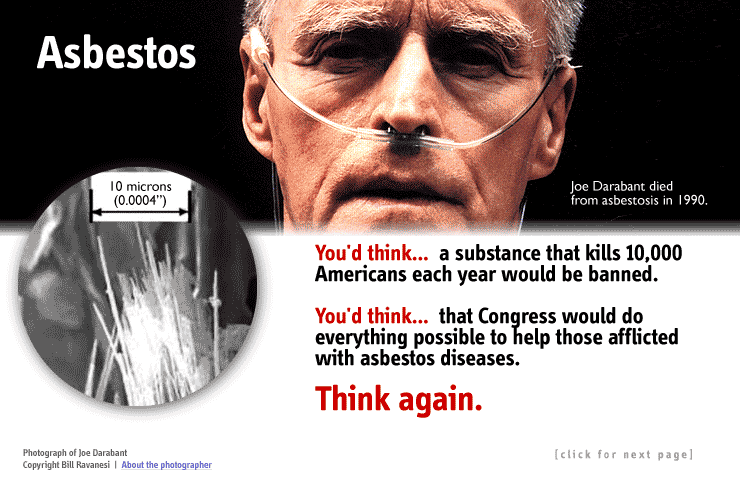Asbestos Resource Center

Asbestos is the single biggest work place killer today. People who have worked with the material are at serious risk from developing lung cancer, asbestosis and mesothelioma, fatal respiratory illnesses that debilitate their victims. Evidence of asbestos’ deadly effect on those who breathe its fibres is likely to multiply in the decades to come.
Asbestos was once heralded as the greatest building material available to those in the construction industries. Its high tensile strength, durability and flexibility, as well as heat insulation and fire retardant properties meant that it could save lives, make buildings strong and make industries rich. It was first used by the Greeks some 2000 years ago. They were aware of the health hazards it posed but believed that its magical ability to withstand fire far outweighed this danger.
The dangers to health were all but ‘forgotten’ until at the turn of the twentieth century when medical researchers noticed a large number of deaths and lung problems occurring in asbestos mining towns. In 1917 and 1918, several United States studies discovered that asbestos workers were dying unnaturally young.
Asbestosis was first diagnosed in a 33 year old woman in 1924, this lead to studies being carried out on asbestos workers in the UK. Examinations on the workers showed that thirty percent had asbestos-related lung disease. UK laws were introduced in 1931 to increase ventilation and to make asbestosis an identifiable work related illness.
Despite the established link between asbestos and lung diseases the industry continued to grow well into the last century. At the peak of its usage asbestos was produced in 24 countries worldwide; it was also manufactured in over 100. World production climaxed at over 5 million tonnes. The building, shipping, insulation and demolition companies whose workers came into contact with asbestos were often aware that their staff were at risk. They did not take sufficient steps to protect their workforce from personal injury.
Sadly the effects of asbestos take many years to manifest themselves. People who worked in the construction industries some 20 to 40 years ago may still be awaiting their fate. Asbestos causes several diseases, two of which occur only in those who have had contact with asbestos, asbestosis and mesothelioma. Lung cancer and emphysema are more commonly associated with smoking but frequently occur in non smokers with a history of asbestos contact.
It is thought that the worst is yet to come. The peak of asbestos usage was in the 60’s and 70’s so many people may develop lung diseases in the near future.
Due to the latency of asbestos diseases it is thought that we will be seeing many more incidences of mesothelioma in the next 25 years. Hugh Robertson, head of health and safety at the British TUC says: "A realistic estimate is that within the EU alone 500,000 will die in the next 35 years, half from mesothelioma and half from lung cancer. In Japan, an estimated 100,000 will die. If you add the Australian, Canadian and US figures then even a million is an under estimation – and that is only for the developed countries.”
People affected by asbestos are entitled to compensation from the companies who knowingly exposed them many years ago.
People affected by asbestos related illness should speak to a personal injury solicitor who has experience in asbestos cases.
For free legal advice visit www.youclaim.co.uk to learn more about asbestos and to make a claim, or alternatively you can call us on 0800 10 757 95.
YouClaims’ solicitors have many years experience of handling asbestos related claims. They help people rebuild their future following exposure to the deadly effects of asbestos.
Editorial notes: YouClaim provides full accident litigation compensation services. Helps people to claim compensation for all types of injury from whiplash to head injuries.
By Sophie Evans
Asbestos Resource Center

